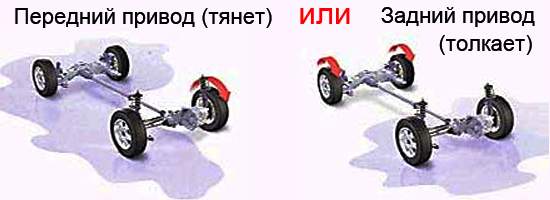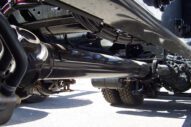
Rear-wheel drive or front-wheel drive?
Content
Why do such automotive concerns as Mercedes Benz, BMW, Lexus still produce cars for rear wheel drive, while 90% of the rest of the cars are front-wheel drive. Let's consider what is the fundamental difference between one or another option, as well as how it affects the technical characteristics and dynamic qualities of the car.
Rear drive device
The most common arrangement for rear-wheel drive is the arrangement in which the engine, being in the front of the car (engine compartment), is rigidly connected to the gearbox, and rotation to the rear axle is transmitted by means of the propeller shaft.
In addition to this arrangement, it happens that the gearbox is not rigidly tied to the engine and is located at the rear of the car, near the rear axle. The propeller shaft in this case rotates at the same speed as the crankshaft (crankshaft).

Rotation to the rear wheels from the engine is transmitted by the propeller shaft.
Rear-wheel drive advantages over front-wheel drive
- During the start, or active acceleration, the center of gravity moves back, which provides better grip. This fact directly affects the dynamic characteristics - it allows faster and more efficient acceleration.
- The front suspension is simpler and easier to service. To the same point can be attributed the fact that the eversion of the front wheels is greater than that of front-wheel drive cars.
- Weight is distributed more evenly along the axles, which contributes to even tire wear and added stability on the road.
- The power unit, transmission are located less densely, which again facilitates maintenance and facilitates easy design.
Rear-wheel drive cons
- The presence of a cardan shaft, which leads to an increase in the cost of the structure.
- Additional noise and vibrations are possible.
- The presence of a tunnel (for the propeller shaft), which reduces the interior space.
Driving performance of various designs
When it comes to good weather conditions, when the tarmac is clean and dry, the average driver will not notice the difference between driving a car with rear wheel drive and front wheel drive. The only place where you can notice the difference is if you put two identical cars with identical motors next to each other, but one with rear-wheel drive, and the other with front-wheel drive, then when accelerating from a standstill, it is the car with rear wheel drive that will have the advantage, respectively, he will travel the distance faster.
And now the most interesting, consider bad weather conditions - wet asphalt, snow, ice, gravel, etc., where grip is weak. With poor traction, rear-wheel drive is more likely to skid than front-wheel drive, let's look at why this happens. The front wheels of a rear-wheel drive car at the moment of turning play the role of “brakes”, not in the literal sense of course, but you must admit that pushing a car with wheels straight ahead and with wheels completely turned out is a completely different effort. Then we get that at the moment of turning, the front wheels, as it were, slow down, and the rear wheels, on the contrary, push, hence the demolition of the rear axle occurs. This fact is used in such a motorsport discipline as drift or controlled skid.
If we consider front-wheel drive structures, then the front wheels, on the contrary, seem to pull the car out of the turn, preventing the rear axle from skidding. From here, there are two main tricks for driving rear-wheel drive and front-wheel drive vehicles.
How to prevent skidding
Rear wheel drive: when skidding, you must completely release the gas, turn the steering wheel in the direction of the skid and then level the car. In no case should braking be applied.
Front-wheel drive: on the contrary, it is necessary to add gas when skidding and always maintain speed (do not release the gas until the car has stabilized).
There are other more professional techniques to which we will devote a separate article.
Good luck on the road, be careful!
Questions and answers:
What is bad rear-wheel drive? Unlike front-wheel drive, rear-wheel drive pushes the car rather than pulling it out. Therefore, the main disadvantage of the rear-wheel drive is the worse handling, although fans of extreme motorsport will argue with this.
Why does BMW only have rear-wheel drive? This is a feature of the company. The manufacturer does not change its tradition - to produce exclusively rear-wheel drive (classic type of drive) cars.
Why are sports cars rear-wheel drive? Under hard acceleration, the front of the machine is unloaded, which reduces traction. For a rear-wheel drive car, this is only good.